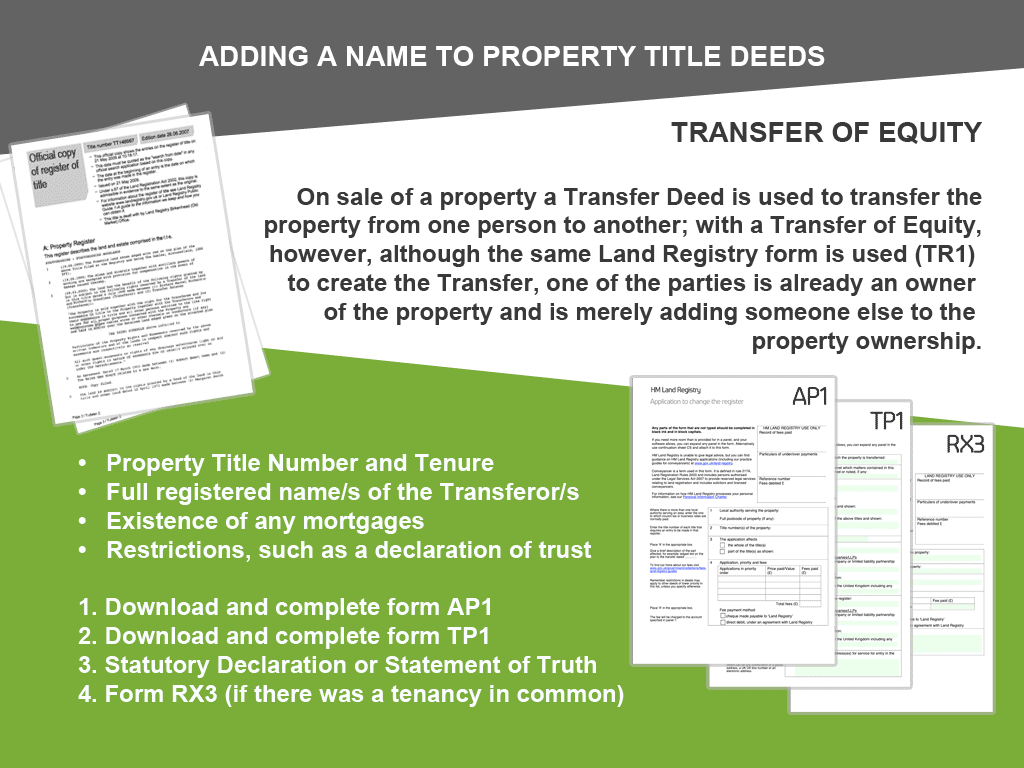Adding a name to the Deeds
Contents
Article Summary
Adding a name to the Deeds really means adding a name to the Title Register, the document that authenticates legal ownership of a property. This article describes the process and explains how to proceed.

Title Register, Title Plan and Deeds
Most people, when asking this question, are actually referring to the ownership documents, which technically are no longer the Deeds, but the Title Register and Title Plan. The old style of property ownership resulted in a stack of Deeds, many of which were handwritten, old, worn and soiled. They were often mislaid, damaged or destroyed. Land Registration now ensures there is always an easy to read, unsoiled, digital copy of the ownership documents available, and these cannot be lost or destroyed. They are known as the Title Register and Title Plan. Many of the old Associated Documents have been scanned and may also be available if they are required.
Adding a name to the ownership documents is normally something carried out within a family and can be done using a Transfer of Equity Deed rather than following the usual conveyancing procedures.
What is a Transfer of Equity?
On sale of a property a Transfer Deed is used to transfer the property from one person to another; with a Transfer of Equity, however, although the same Land Registry form is used (TR1) to create the Transfer, one of the parties is already an owner of the property and is merely adding someone else to the ownership.
Examples of the use of a Transfer of Equity are:
- Property owned by A and B. B wishes to transfer his interest to A, so that A becomes the sole owner;
- Property owned by A. A wishes to add B to the ownership;
- Property owned by A and B. A and B wish to add C to the ownership.
- Property owned by A and B. B wished to be removed from the ownership.
The conveyancing for a Transfer of Equity is simpler and quicker than with a sale, and would normally be provided more cheaply.
You will need a Title Register to prepare the Transfer of Equity
The person transferring (known as the Transferor) will need to obtain an up to date copy of the Title Register. This document provides important detail that your solicitor requires, e.g.
- Title Number
- Tenure
- Full registered name/s of the Transferor/s (the registered names may appear differently than they are in actuality. Your solicitor will need to see the names as registered, and apply to replace the names with the correct ones if necessary. There are often spelling mistakes, missing middle names, etc., which have consequences when applying for official documents such as a passport, which would be refused if the names on an application form do not match the registered documents).
- Existence of any mortgages. If there are any such, the mortgagee's written consent will be required before proceeding further.
- Restrictions, such as a declaration of trust where there is a tenancy in common (see below)
Obtain an up to date copy of the Title Register
Once you pass these documents to your solicitor he will prepare the Transfer Deed and it can be signed as soon as he has done so.
Joint Tenancies and Tenancies in Common
Where the property is owned by the parties as beneficial joint tenants, which is the default position, the above procedure is followed. Where it is owned as a tenancy in common, there will be a Restriction in the Title Register which will prevent a Transfer to a sole owner.
Sample Title Register extract found in Section B, showing the existence of a Tenancy in Common
RESTRICTION: No disposition by a sole proprietor of the registered estate (except a trust corporation) under which capital money arises is to be registered unless authorised by an order of the Registrar or the court.
This means that If the Transfer is created to remove a person from the Title Register, and no money is being paid by the remaining sole owner, it will also be necessary for your solicitor to prepare a Declaration confirming that the remaining sole owner is solely entitled to the equity in the property; Land Registry form RX3 should also be prepared and sent to the Land Registry to remove the Restriction.
Documents to be filed with the Land Registry
Title Register
The Land Registry Title Register holds data relating to the property ownership, purchase price, mortgage, tenure, covenants, rights of way, leases and class of title.
£19.95Title Plan
The Title Plan shows an outline of the property and its immediate neighbourhood, and uses colours to identify rights of way, general boundaries and land affected by covenants.
£19.95Associated Documents
Deeds creating Restrictions, Covenants, Easements, etc. are often kept digitally by the Land Registry and made available for sale due to their invaluable detail and content to assist in further understanding the Restrictions, etc.
£29.95


